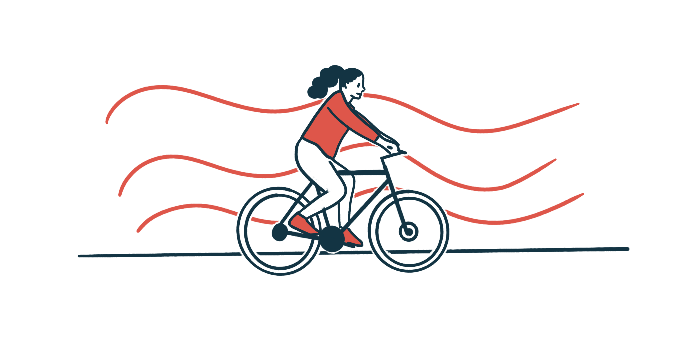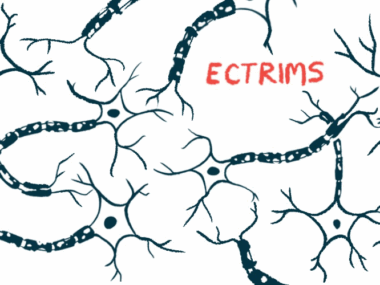Aerobic cycling eases fatigue and pain of MS, if intensity kept up
Study looks at 12 weeks of fast cycling with or without motorized assistance
Written by |

Adhering to an aerobic exercise program of moderate to intense cycling for 12 weeks significantly eased pain and fatigue in people with multiple sclerosis (MS), allowing them to be more active in daily life, a small pilot clinical trial found.
Results were similar for patients in the trial’s forced exercise group, in which a motor was used to help them pedal at a pre-determined intensity rate, and in those pedaling without assistance but aiming for a similar rate.
“Aerobic exercise should be considered as part of a multi-faceted approach to improve pain and fatigue” in MS patients, the researchers wrote.
Findings in “Aerobic cycling reduces fatigue and improves pain in persons with multiple sclerosis: A preliminary study” were published as a correspondence in the journal Multiple Sclerosis and Related Disorders.
Regular intense cycling seen as way of getting aerobic exercise benefits
Muscle weakness, pain, and fatigue are some of the most common symptoms of MS, and all have a significant impact on life quality.
Research has shown that exercise with MS, particularly aerobic exercise that increases heart rate, helps to lessen fatigue and pain in the general population. However, muscle weakness and spasticity (stiffness) can prevent MS patients from regular exercise at appropriate levels.
To overcome this, researchers at the Cleveland Clinic devised an approach called forced aerobic exercise, in which a motor supplements a patient’s voluntary efforts at pedaling.
A cycle ergometer on the semi-recumbent stationary bike was engineered to keep patients pedaling at a moderate to high-intensity rate of at least 70 rotations per minute, helping them to “achieve and sustain greater exercise intensity thought necessary to improve fatigue and pain,” the team wrote. Results were compared with a self-pedaling control patient group.
Researchers’ clinical trial (NCT04906057) enrolled 18 patients followed at their Ohio MS clinic, who were randomly assigned to either a forced or regular cycling program for 12 weeks, or about three months, of 45-minute exercise sessions given twice a week.
The average exercise cadence, or cycling revolutions per minute, was 69.1 in the forced exercise group and 64.5 for those pedaling at moderate or high intensity without assistance. Targeted aerobic cycling intensity was set at 60% to 80 % of maximum heart rate for each patient by age.
Participants had a mean age of 55, and a majority were women (55.6%). Ten had relapsing-remitting MS (55.6%), seven had secondary progressive disease, and one had primary progressive MS. Their disability ranged from minimal to substantial walking impairments.
At the beginning and end of the intervention, patients were asked to report their fatigue using the Modified Fatigue Impact Scale (MFIS) questionnaire, as well as their health-related quality of life, assessed with the Patient-Reported Outcome Measurement System (PROMIS)-29.
Forced, or assisted, cycling may help in keeping a more intense pace
People in both exercise groups reported significant reductions in fatigue levels, as shown by a reduction in total MFIS scores from a mean of 21.9 to 17. Significant improvements also were seen in physical fatigue, with scores dropping from a mean of 14.1 to 10.5.
“The decrease in total MFIS of 4.9 after the intervention meets the threshold for a minimally clinically important difference” for people with MS, the researchers wrote.
Patients also reported a significant easing in pain intensity, a subscale of the PROMIS-29 questionnaire, with scores decreasing from 3.5 to 2.8. The degree to which pain severely interfered with daily life activities also fell markedly.
No significant differences were seen between both aerobic exercise modalities, but the team noted that patients with greater limitations may find keeping an aerobic level easier with an assisted cycling rate than a voluntary one.
“We previously reported in our feasibility outcomes that one individual who presented with an EDSS of 6.5 [indicating a need for two aids to walk 100 meters] was not able to complete [the self-paced exercise program], but successfully completed the 12-week intervention using the FE [forced exercise] cycle,” the scientists wrote.
This small study shows that “while both modes of aerobic cycling were tolerated and effective in reducing pain and fatigue in persons with mild to moderate degrees of disability, FE may represent a viable alternative to traditional exercise for persons with advanced stages of or other physical limitations associated with MS,” they concluded.






